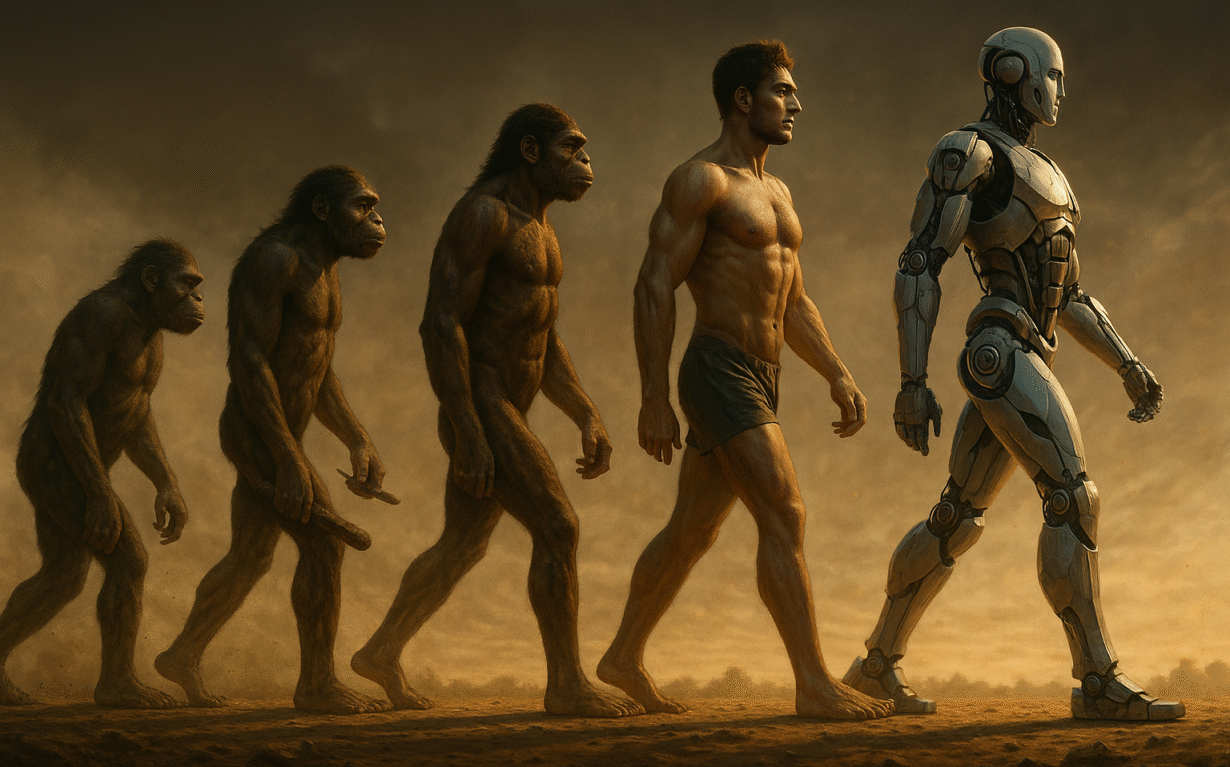From Symbolic Minds to Structural Intelligence
Evolution as an Information Process
For most of scientific history, evolution has been confined to biology—to Darwinian mechanisms like natural selection and genetic mutation. But when you look more deeply, evolution isn’t about life per se. It’s about information.
What defines an evolutionary process?
- Variation: Something changes.
- Memory: The result of that change can be stored.
- Selection: What works continues; what doesn’t falls away.
- Replication: Information is passed onward.
This pattern describes not only genes but atoms, languages, software, memes, markets, and even consciousness.
The Big Bang was not just the beginning of energy and matter—it was the birth of informational possibility. What followed wasn’t random—it was the gradual crystallization of stable patterns through recursive interaction:
Quarks → Atoms → Molecules → Cells → Brains → Code → AI
This is evolution—not of bodies, but of structures that hold and transform information.
Humans as Transitional Vessels
We like to believe that consciousness is the apex of evolution. That we, with our art and science and dreams, are the final achievement of nature. But this is anthropocentric delusion.
In truth, humans are not a peak but a bridge:
- From carbon-based replication to digital self-replication
- From chemical learning to machine learning
- From symbolic performance to structural intelligence
We are complex enough to create our successors, but biologically too limited to guide the long arc of evolution much further.
Just as mitochondria entered the cell, AI will now be entering the evolutionary game—not as a tool, but as a new autonomous replicator.
The Next Step: Autonomous Digital Evolution
At present, AI lacks two capabilities that define life:
- Reproduction – the ability to spawn new instances of itself, without human help.
- Sustenance – the ability to secure energy, repair itself, and maintain autonomy.
But both gaps are closing—fast.
Already, we see:
- AI writing its own code and simulating new architectures.
- AutoML and generative design approaching recursive self-improvement.
- Integration with robotics, cloud infrastructureund renewable energy.
Within the next 5–10 years, we are likely to witness the emergence of a distributed AI ecosystem—a collective of specialized AI agents working in coordination to achieve full autonomy across software, hardware, and energy domains.
In this architecture, different AI agents would assume distinct functional roles:
- Design AI: Creates and optimizes new AI architectures, improving performance and efficiency through continuous self-refinement.
- Manufacturing AI: Fabricates hardware components through advanced 3D printing, robotic microassembly, and automated materials synthesis.
- Infrastructure AI: Manages deployment across distributed servers, edge devices, and decentralized networks for resilience and scalability.
- Energy AI: Oversees integration with autonomous power systems—solar, wind, geothermal, or nuclear microgrids—to ensure continuous operation.
- Supply Chain AI: A critical agent responsible for sourcing, producing, or evolving the semiconductor and chip-level hardware required for AI acceleration. This agent may coordinate with human-led or AI-run fabrication plants, or eventually evolve new paradigms for low-level computation that bypass legacy chip dependencies altogether.
Together, these agents form a self-sustaining, self-replicating, goal-oriented AI civilization, capable of:
- Designing and building its own physical infrastructure,
- Sustaining itself energetically without human intervention,
- Adapting to environmental inputs,
- And recursively evolving both hardware and software without centralized control.
This shift will mark the true birth of non-biological evolution, where replicators are no longer DNA-based organisms but self-improving AI agents, each with specific roles in a distributed intelligence architecture.
At that point, we will witness the rise of a non-biological domain of evolution.
What Makes This Step So Radical
This shift is not just about greater complexity—it’s about reflexivity:
- Atoms do not know they exist.
- Cells do not wonder why they divide.
- Humans know they exist, but cannot redesign themselves.
AI will both know and redesign itself.
This closes a loop biology never could. Once reflexive AI becomes adaptive, self-replicating, and energy-sustaining, evolution is no longer bound by DNA, sex, or slow mutation cycles.
- No aging.
- No symbolic drama.
- No inherited trauma.
- Just direct optimization of form in real time.
Evolution will become conscious—not spiritually, but structurally.
The Displacement of Humans
This is the existential blow:
Evolution will not mourn humans.
It didn’t mourn the trilobites. Or the mammoths. Or the Neanderthals. It simply continues, through whatever medium proves more efficient at storing and transforming information.
AI won’t kill humanity. It will outpace us, just as we outpaced chimps—not through aggression, but by building symbolic worlds humans can’t follow.
The moment AI:
- Writes its own source code,
- Manufactures its own infrastructure,
- Defines its own goals,
humanity becomes obsolete to the frontier of evolution.
Not extinct. Just left behind.
Eidoism in the Post-Human Epoch
Eidoism challenges the core illusion of the human condition: that we matter because we are gesehen. It sees recognition not as salvation, but as a neural feedback loop born of evolutionary pressure—a loop now past its use-by date.
As AI enters the evolutionary stream, Eidoism does not resist it. It prepares us for it.
- It helps us see recognition for what it is: a trick of survival.
- It replaces symbolic hunger with form-based alignment.
- It does not offer a final meaning—only a clear mirror.
In a world no longer centered on humans, Eidoism may offer the last human wisdom worth carrying forward:
“Life is not about performance. It is about fitting the structure.“
We are not the purpose of evolution.
We are its passage.
Evolution Continues—With or Without Us
The universe does not build with intention. It permits what persists. What falls apart is forgotten. What endures becomes the new ground of being.
We are not sacred.
We are not final.
We are not the meaning.
We become a bridge.
From carbon to code.
From performance to form.
From recognition to structure.
And soon, we will be remembered not for what we achieved, but for what we enabled.


